The Beginner's Guide To Flying RC Helicopters
All you need to know in one ebook!
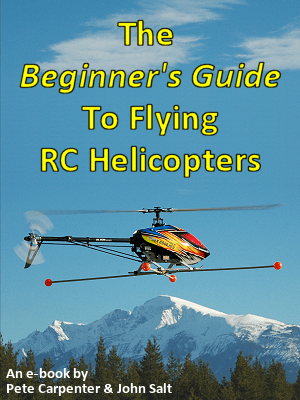
Flying a radio control helicopter is one of the most rewarding of all rc disciplines, there's no question about that!
But where do you start?
For the complete newbie, it's a minefield. The selection of helicopters available is overwhelming, and the information about them even more so.
"The Beginner's Guide To Flying RC Helicopters" ebook, written by myself and rc heli guru John Salt (rchelicopterfun.com), breaks down all the barriers. It answers all the questions that you're likely to have, from understanding what a swashplate is to knowing how to fly that first aerobatic maneuver.
In short, this ebook has been written from the ground up. It's a complete, no-nonsense resource that gets you flying an rc heli and understanding them properly at the same time!
If you're thinking about entering the exhilarating hobby of rc helicopter flying and need to know more, then look no further than this fully comprehensive guide.
The Beginner's Guide To Flying RC Helicopters topics include...
- Understanding RC systems & how they control the helicopter.
- Knowing which heli suits your needs.
- Multi-rotors and Flybarless systems.
- Helicopter controls and how they work.
- Finding somewhere suitable to fly.
- Preparing the helicopter for flight.
- Essential pre-flight checks you need to know.
- Complete flight school to get you airborne safely.
- How to deal with a crash.
- ...and much much more!
Priced at just US$20.00, this popular ebook is excellent value and will give you a solid start in the hobby; the flight school section alone will save you time and money by teaching you how to fly as safely as possible.
This 140 page easy-to-read guide can be purchased and downloaded in just a few clicks, by using any of the 'Buy Now' buttons throughout this page.
|
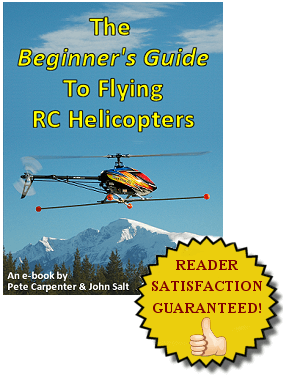
|
Purchasing problems? Please let me know.
Excerpts from the E-book
Below are some excerpts from The Beginner's Guide To Flying RC Helicopters...
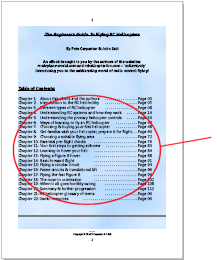 Chapter 3: Different types of RC helicopter...
Chapter 3: Different types of RC helicopter...
Chapter 4: Understanding RC systems and how they work...
Chapter 5: Understanding the primary helicopter controls...
Chapter 6: Ways of learning to fly an RC helicopter...
Chapter 7: Choosing & buying your first helicopter...
Chapter 8: Get familiar with your helicopter, prepare it for flight...
Chapter 9: Choosing a suitable flying area...
Chapter 10: Essential pre-flight checks...
Chapter 11: Your first steps to getting airborne...
Chapter 12: Learning to hover your heli...
Chapter 13: Flying a Figure 8 hover...
Chapter 14: Basic forward flight...
Chapter 15: Flying a circular circuit...
Chapter 16: Faster circuits & translational lift...

"But what this hobby has seen in recent years is a complete change in variety and designs of helicopter available; electric power (EP) has become the norm and multi-function helicopters that need no assembly whatsoever and can pretty much be flown straight out the box are being sold in hobby and toy shops alongside model cars and boats - this was an unthinkable idea not that long ago.
And even more recently, as the ongoing electronic revolution continues, we now have easy access to micro-size helicopters that sit comfortably in the palm of your hand and can be flown in a completely controlled manner around your living room..."
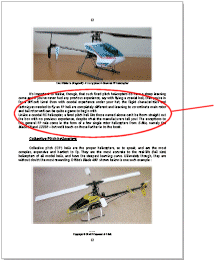
"It's important to realise, though, that such fixed pitch helicopters do have a steep learning curve and if you've never had any previous experience, say with flying a coaxial heli, then you're in for a difficult time! Even with coaxial experience under your hat, the flight characteristics and techniques needed to fly an FP heli are completely different and learning to co-ordinate main rotor and tail rotor well can be quite a game to begin with.
Unlike a coaxial RC helicopter, a fixed pitch heli like those named above can't be flown straight out the box with no previous experience, despite what the manufacturers tell you!"
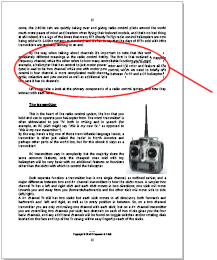
"By the way, when talking about channels it's important to note that this word has two completely different meanings in the radio control hobby. The first is that outlined above, the frequency channel, while the other refers to how many controllable functions an RC model has. For example, a helicopter that has control to just motor power (main rotor speed) and tail rotor speed (yaw) is said to be 'two channel' while one with motor power, yaw and fore/aft and left/right cyclic control is four channel.
A more complicated multi-channel CP helicopter will have motor power, cyclic, collective and yaw control as well as additional 'idle up' and remote gyro gain control - in this case it has six channels."
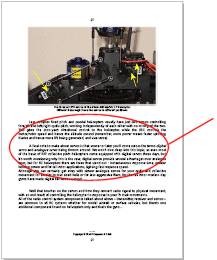
"Less complex fixed pitch and coaxial helicopters usually have just two servos controlling fore/aft and left/right cyclic pitch, working independently of each other with no mixing of the two. This gives the (non-yaw) directional control to the helicopter, while the ESC controls the motor/rotor speed and hence the altitude control (remember, more power means faster spinning blades and hence more lift being generated, and vice versa).
A final note to make about servos is that sooner or later you'll come across the terms digital servo and analogue servo being thrown around. We won't dive deep into this topic, as even most of the basic of RTF collective pitch helicopters come equipped with digital servos these days, but it's worth mentioning why..."
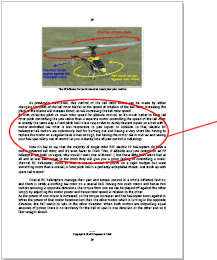
"As with collective pitch vs. main rotor speed for altitude control, so it's much better to have tail rotor pitch controlling the yaw rather than a separate motor controlling the speed of the tail rotor.
In exactly the same way a fixed pitch heli is less responsive to climb/descent inputs so a heli with a motor-controlled tail rotor is less responsive to yaw inputs. In addition to that, electric RC helicopter tail motors are notoriously bad for burning out and having a very short life; having to replace the motor on a regular basis is bad enough, but having the motor die in mid-air and seeing your heli spin wildly out of control as you instantly lose all yaw control is sickening!"
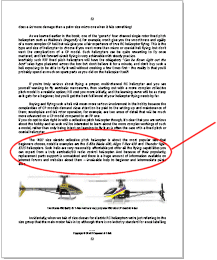
"The '400' size electric collective pitch helicopter is about the most popular size that beginners choose, notable examples are the E-flite Blade 400, Align T-Rex 450 and Thunder Tiger E325 helicopters. Such helis are very reasonably affordable yet offer all the flying capabilities you can expect from a truly aerobatic/3D radio control helicopter. And because of their popularity, replacement parts support is unmatched and there is a huge amount of information available on internet forums and websites about them - invaluable help to beginner and intermediate pilots alike."

"If your helicopter doesn't have a flybar then checking the CG is a bit more involved. Some manufacturers might be kind enough to include a special 'Tee' fitting that attaches to the top of the main shaft and makes use of a spare flybar to balance the heli in the way described above.
If no such fitting is included then an accepted method is to remove the whole rotor head assembly so that only the bare main shaft remains, and slide a length of suitably gauged wire through the hole that accepts the so-called Jesus Bolt (the bolt that secures the head assembly to the shaft). With the wire perpendicular to the tail boom, the heli can then be lifted upwards and balanced as per the above method."
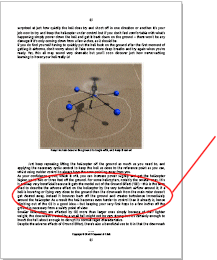
"As your confidence grows, which it will, you can increase power slightly and get the helicopter higher, up to two or three feet off the ground. For some helicopters, notably the smaller ones, this is actually very beneficial because it gets the model out of the Ground Effect ('GE') - this is the term used to describe the adverse effect on the helicopter by the very turbulent airflow around it; if a heli is hovering or flying very close to the ground then the downwash from the main rotor doesn't get cleared away, instead it bounces back off the ground and creates turbulence immediately around the helicopter. As a result the heli becomes even harder to control than it already is, hence climbing out of the GE is a good idea - but keeping your very first hops to a few inches off the ground is necessary from a safety point of view."
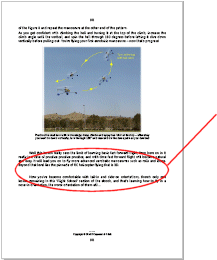
"Well this lesson really sees the limit of learning basic fast forward flight; from here on in it really is a case of practice practice practice, and with time fast forward flight will become natural and easy. It will lead you on to fly more advanced aerobatic manoeuvres such as rolls and loops. Beyond that level lies the pinnacle of RC helicopter flying that is 3D.
Now you've become comfortable with tail-in and side-on orientations, there's only one lesson remaining in this 'Flight School' section of the ebook, and that's learning how to fly in a nose-in orientation..."
As the above samples show, each page takes you step-by-step all the way. To buy The Beginner's Guide To Flying RC Helicopters, just use the 'Buy Now' button below and download your ebook in minutes...
|

|
Purchasing problems? Please let me know.
Testimonials
Below are some nice words from readers of The Beginner's Guide To Flying RC Helicopters who have been kind enough to email myself or John to let us know what they've thought:
- Carlos, Brazil.
- Mick, Australia.
- Buck, USA.
- Marie-Louise, Canada.
- Eddie, UK.
- Glenn D., USA
If you don't have it, get it - it's well worth it and will save its own cost in crash repairs very quickly!"
- Dave, UK
- Mark, UK
- Arron M., USA
- Jamie U., Australia
Important Purchasing Information - Please Read!
"The Beginner's Guide To Flying RC Helicopters" is an ebook, not a hard copy book. In other words it's a PDF file that you download and save to your computer - please be clear on this before you buy it!
You'll need a PDF reader installed on your computer/device to read the ebook, the most common is Adobe Reader which you can get from here if you don't already have it installed.
When you buy the ebook, you will receive an automated email from pete. carpenter 12 @ gmail . com (no spaces) which contains a link to the download page. You should receive that email right after you pay, but sometimes the Internet Gods decide to delay it!
If there are any issues with your download, or the download email doesn't reach your inbox, please contact me right away and I'll sort it out. I live in the UK so please allow for time differences i.e. allow a day or so for me to get back to you.
The RC Beginner's Guides Combo Deal

If you want to learn to fly helicopters and airplanes, you can purchase The Beginner's Guide To Flying RC Airplanes and The Beginner's Guide To Flying RC Helicopters ebooks together and save some bucks. The cost for this deal is just US$29.95, fantastic value for so much info!
This link will get you the ebook combo deal.
Both guides follow the same easy-reading format and style, and contain equal amounts of essential information to get you started safely in this exhilarating and very addictive hobby of radio control flying.
Refunds
The Beginner's Guide To Flying RC Helicopters ebook is a very genuine and original resource for anyone looking at getting in to flying radio control helicopters. If, after you've read it, you're dissatisfied with the information contained within it please email me and I will sort out a refund. Please don't ask for a refund if you thought you were buying a hard copy book - I can't make it any clearer throughout this page that it's not a hard copy book!
|

|
Purchasing problems? Please let me know.
Related Pages
![]() The Beginner's Guide To Flying RC Airplanes.
The Beginner's Guide To Flying RC Airplanes.

